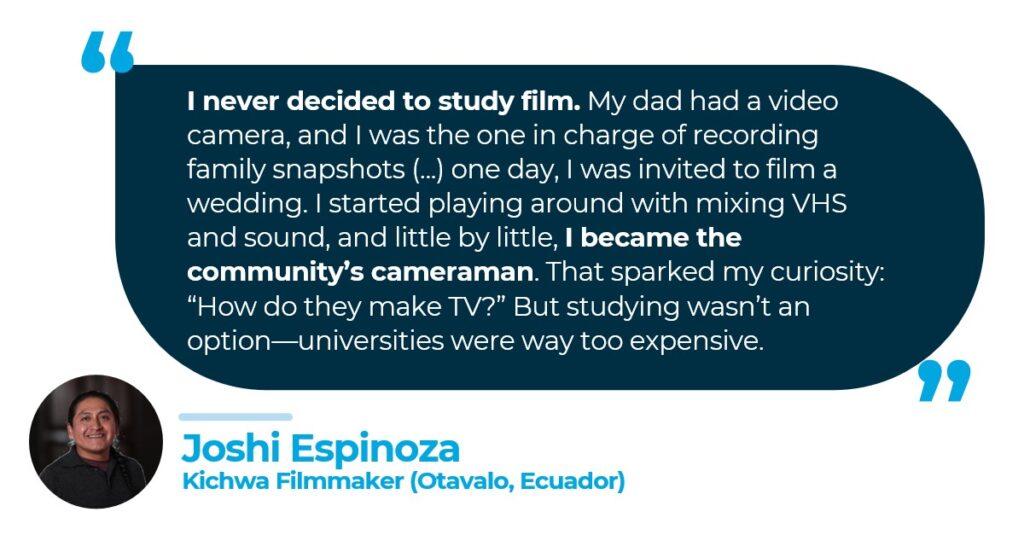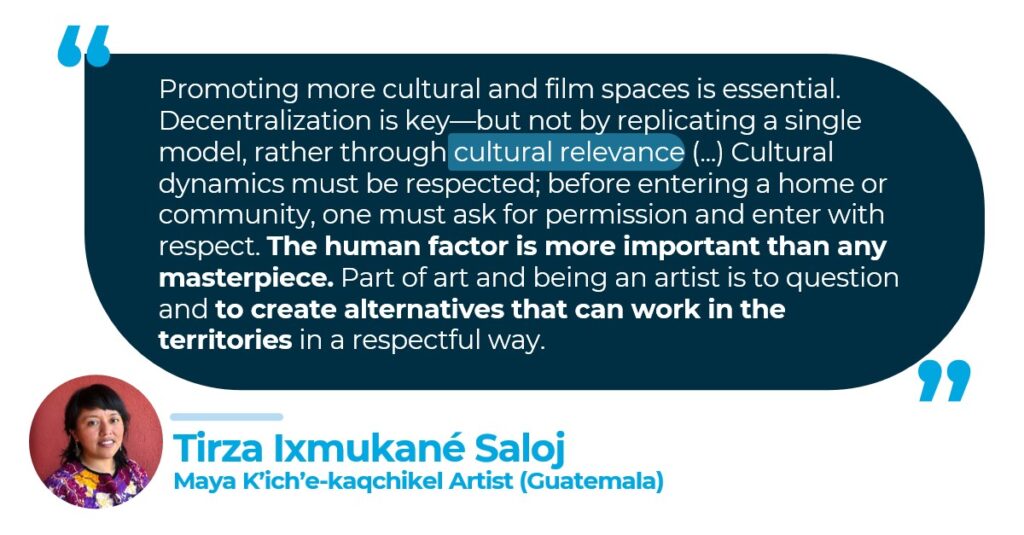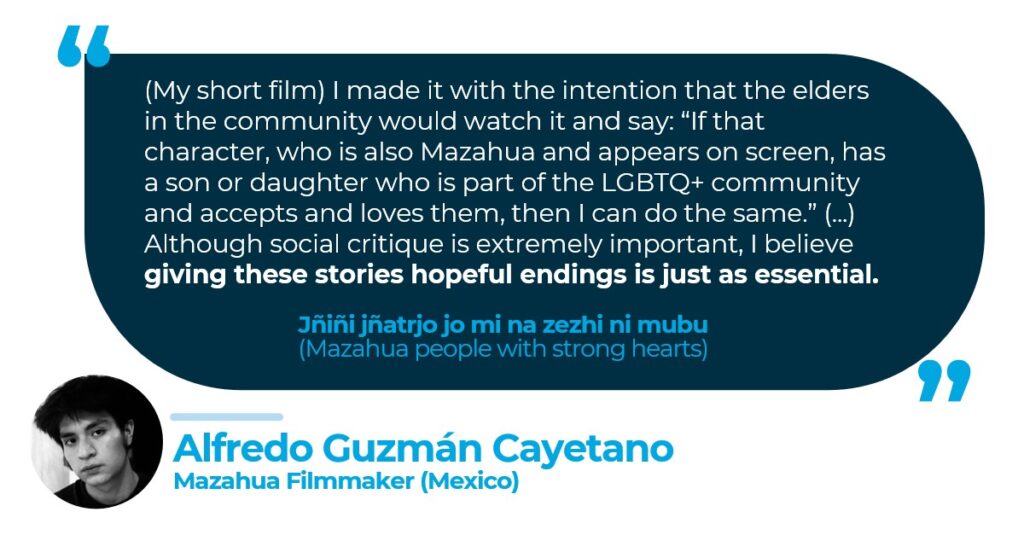Creative industries are increasingly offering a wider variety of formats and themes. However, the characters, settings, and realities we see do not necessarily reflect the full diversity present in Latin America and the Caribbean, or in the world. This is where Indigenous representation in creative industries becomes especially relevant.
In this article, we explore the stories of three Indigenous filmmakers who are transforming Latin American creative industries through culturally relevant Indigenous cinema: Joshi Espinosa, Alfredo Guzmán Cayetano, and Tirza Ixmukané Saloj.
Cinema: A Powerful Yet Inaccessible Tool
The path to becoming audiovisual artists was very different for Joshi, Alfredo, and Tirza. For Joshi, a Kichwa Otavalo Indigenous filmmaker from Ecuador, it happened almost by accident:

After several years, a Kichwa musician asked Joshi for help making music videos. Self-taught, Joshi forged ahead: “I bought a computer I didn’t know how to use. At that time, there was no Internet, so I had to go to the university—this very expensive university I mentioned. I’d go into the library, where there were manuals on how to edit with certain programs. I’d make photocopies and then go home, read them, and that’s how I learned to edit.”
In the case of Tirza, a K’ich’e-Kaqchikel Maya Indigenous artist from Guatemala, it was another colleague—who had received a scholarship to study film—who introduced her to this world by inviting Indigenous artists to participate. Like Joshi and Alfredo, Tirza agrees that studying film was an inaccessible dream.
“Going to the movies is still an investment that excludes many people—it’s a big expense for families. I didn’t get close to cinema until I was 12, when my sister started taking us. I grew fond of it, especially when a film came out with a soundtrack in Mazahua, my community’s language (…) That’s when I started seeing more Indigenous filmmakers.” — Alfredo Guzmán Cayetano, Mazahua filmmaker from Mexico
For all three, audiovisual language holds a special power to tell the stories and express the needs of their communities—motivating them to pursue this profession despite the challenges.
Development with identity in the arts
Indigenous people working in the audiovisual industry contribute to their communities in multiple ways:
- Their participation promotes access for more Indigenous artists to training in creative industries like film. Creative industries generate $124 billion in revenue, represent 2.2% of the regional GDP, and employ nearly 3 million people. This can become an opportunity for economic development in Indigenous communities—for example, by attracting tourism and creating jobs through hiring artists, assistants, and other workers in towns during filming periods.
- They strengthen the relevant representation of Indigenous stories and contexts, which have historically been made invisible in cinema. In this regard, they emphasize that it’s not only about having Indigenous representation but also ensuring that it is respectful and contextualized—based on a vision of development with identity.

Portraying Indigenous Communities as They Are (and as We Dream Them)
When discussing representation, it’s important to consider the aspect of intersectionality. The Indigenous identity of characters in film should reflect an important part of their lives—but not the only one.
Tirza, Joshi, and Alfredo all emphasize the importance of portraying the specific aspects that come with being part of a community. It would be a mistake to depict all Indigenous peoples in a homogeneous way, especially given the transformations communities are currently experiencing. At least 50% of the entire Indigenous population in Latin America and the Caribbean lives in cities, yet they continue to be represented in rural settings.
“Sometimes people from non-Indigenous backgrounds portray Indigenous characters—and that’s okay, because all voices deserve to be heard. But due to a lack of knowledge or prejudice, they sometimes do so in violent, folklorized, clichéd ways, or they replicate tokenism.” — Tirza Ixmukané Saloj
As Joshi affirms, efforts to include more Indigenous voices in this industry are key to preserving the traditions and identity of their peoples: “Many Indigenous communities, particularly the smaller ones, are eager to have who we are—our language—documented before we disappear. Art is proof that we exist.”
Tirza shares this vision:
“Art is a safeguard of our heritage (…) We have the need to tell our stories (…) it’s important to use technology to document our territories, to leave something for future generations.”
Meanwhile, Alfredo holds on to the hope that, through screens, it’s also possible to create new imaginaries that reduce stereotypes: “Cinema doesn’t exist only to talk about how the world is, but also about how we want it to be. When we talk about other possible realities, people think ‘if it’s possible, I can be part of that.’”


What Initiatives Promote Indigenous Representation in the Creative Industries?
- Art and Transformation Program. Through this initiative, the IDB supports contemporary Indigenous artists by integrating their work into its Art Collection. Exhibitions such as “Amazonas: A Hub of Biocreativity” and “Emergent Voices” have supported artists from Brazil, Venezuela, Peru, Ecuador, Colombia, Guatemala, and various Amazonian peoples.
- Morelia Film Festival. Through its Project Development Lab for Indigenous Filmmakers, this renowned festival offers training opportunities to Indigenous filmmakers from across the region. We thank the Morelia Film Festival organization for connecting us with Tirza, Joshi, and Alfredo—participants in the 2023 edition, which featured 15 filmmakers from 13 Indigenous peoples and 7 countries in the region.


Leave a Reply